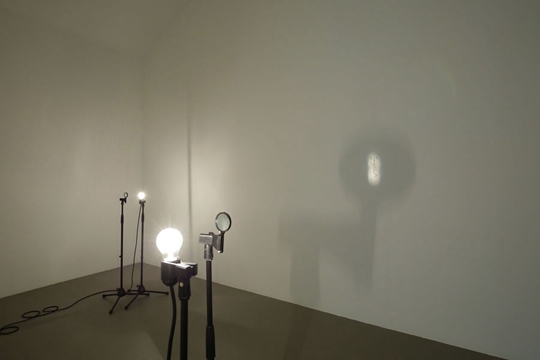Takao Minami: Medi
| 2016年12月23日

Consider the travelogue. Some sensitive soul alights in a part of the world somehow different from their home, and they enact a traversal of this space, accruing images and relating experiences in a roughly linear fashion. Eventually it all grinds to a conclusion, in connection with the point of departure or perhaps the experience of flying itself — but not so with “Medi,” a solo presentation by the Japanese artist Takao Minami.
The titular work of the exhibition, Medi (2016), apparently takes its name from a contraction of the Mediterranean Sea, the artist’s travels around which underpin the work. On one hand, the contraction might suggest diminution, polishing something as weathered and careworn as the Mediterranean into something shiny and cute. At the same time, it could also be taken for some curious rebracketing of the same, isolating its prefix to evoke some sense of neutrality, mediation, and abstraction.
For the most part, the exhibition is dominated by this one work—its constituent video projections occupy an entire wall of the gallery, with no other works in its immediate presence to interfere with the experience. A bench is helpfully provided, but the work’s vertical orientation and comparatively brief duration of nine minutes seem to enjoin us to stand, and reckon with it from a similarly vertical angle.

Due to the scale of the work, and the particular dimensions of the gallery, it is fairly likely that, while looking at it, at least some of the artwork will be in your peripheral vision. Whether or not the result is overwhelming, it nevertheless contributes to the overall sense of scale. Add to this is a continuous motion on the part of each panel of the work—consistently “upwards” for the most part—and the result is a vertiginous sense of being on the verge of falling into the projected images.
Rendered in acidic, eye-poppingly vivid colors, the subjects in these vertical scrolls include clouds, waterfalls, waves, construction work, shepherds, fences, cable cars, boats, kites, and swarms of insects, compressed into the same, improbable plane—as improbable, perhaps, as the graphical appearance that the high-contrast colors lend to the work. Despite the generally consistent upward motion of these images, the constituent visuals are frequently set at odd angles, even upside down, disrupting any attempt at orienting yourself relative to some stable horizon.

Standing in stark contrast to the sensory smörgåsbord offered by Medi, which achieves, at the very least, attention and accessibility through optical saturation, the two other works in the exhibition are spare enough to yield a palpable sense of disorientation if viewed immediately afterwards. Light Symbol #5 (2016) and Shadow Symbol #3 (2016) at first glance appear to consist of little more than bare incandescent bulbs on stands, each with a lens focusing its bulb’s light onto a spot on the wall.
As tungsten-filament bulbs fade into obsolescence, every successive instance of their use invites some amount of scrutiny, though it’s arguable whether LED or fluorescent bulbs would have worked with these works’ “bare wire, exposed infrastructure” aesthetic. The semiotics of lighting aside, one diverting aspect to these works is how they project little characters on the walls—the answer being that the tiny inscriptions are on the bulbs themselves, difficult to spot without getting blotches in your field of vision. These inscriptions correspond to their titles, but in Chinese bronze script for “Light Symbol #5” and Egyptian hieroglyphics for “Shadow Symbol #3,” essentially guaranteeing that almost no one would be able to understand without knowing the titles, which imparts to the works themselves a curious sense of muteness.
Takao Minami: Medi
Ota Fine Arts, Singapore
September 23 – November 5, 2016

